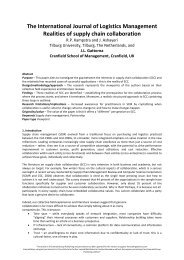customer segmentation based on buying and ... - John Gattorna
customer segmentation based on buying and ... - John Gattorna
customer segmentation based on buying and ... - John Gattorna
You also want an ePaper? Increase the reach of your titles
YUMPU automatically turns print PDFs into web optimized ePapers that Google loves.
systematic <str<strong>on</strong>g>segmentati<strong>on</strong></str<strong>on</strong>g> model. This research shows <strong>on</strong>e possible approach is to use<br />
return data as a vital part of the model <strong>and</strong> complement it with purposefully collected data<br />
c<strong>on</strong>cerning <strong>buying</strong> behaviour (Ericss<strong>on</strong>, 2011). This fits quite well with the evolving<br />
dem<strong>and</strong> chain approach with its focus <strong>on</strong> c<strong>on</strong>sumer behaviour, insight <strong>and</strong> alignment of<br />
marketing, sales <strong>and</strong> logistics activities.<br />
It also goes h<strong>and</strong> in h<strong>and</strong> with the development of retailing with increasing co-creati<strong>on</strong><br />
<strong>and</strong> reliance <strong>on</strong> social media. The term co-creati<strong>on</strong> is not new, however, but it is now<br />
receiving more attenti<strong>on</strong> as companies endeavour to differentiate themselves from the<br />
competiti<strong>on</strong>. Where in the past value was created by companies in the chain, value today<br />
is co-created at multiple points of interacti<strong>on</strong>. Not <strong>on</strong>ly the physical product, but also the<br />
services in the value package can be co-created. RM is <strong>on</strong>e of the most promising areas<br />
for co-creati<strong>on</strong>!<br />
To summarise these research findings <strong>and</strong> relate the results to the overarching<br />
hypotheses <strong>and</strong> research purpose, the authors c<strong>on</strong>clude that there is c<strong>on</strong>clusive support<br />
for both hypotheses. The behavioural model described in this pattern shows that<br />
<str<strong>on</strong>g>customer</str<strong>on</strong>g>s behave in a heterogeneous way <strong>and</strong> this indicates that the “<strong>on</strong>e size fits all”<br />
theory is obsolete as the literature indicates (Christopher et al., 2006; <strong>Gattorna</strong>, 2010;<br />
Ericss<strong>on</strong>, 2011; Godsell et al., 2011). Theresultsalsosupportpreviousfindings that RM is<br />
an important part of the supply chain (Norek, 2002; Rogers et al., 2002; Stock et al.,<br />
2006; Mollenkopf et al., 2007a; Mollenkopf et al., 2007b; Frankel et al., 2010;<br />
Mollenkopf, 2010), asc<strong>on</strong>sumerreturnsareanimportantpartofe-commerce <str<strong>on</strong>g>customer</str<strong>on</strong>g><br />
behaviour <strong>and</strong> therefore important both to the case organisati<strong>on</strong> <strong>and</strong> its partners,<br />
including the <str<strong>on</strong>g>customer</str<strong>on</strong>g>s. Further, Mollenkopf (2007b) highlights the risks involved in e-<br />
commerce <strong>and</strong> the importance of RM in the service recovery process.<br />
This research empirically supports the importance of RM in the service recovery in fashi<strong>on</strong><br />
e-commerce, as quite a large group of <str<strong>on</strong>g>customer</str<strong>on</strong>g>s are systematically returning. However,<br />
companies using a “<strong>on</strong>e size fits all approach” are focusing solely <strong>on</strong> RM efficiency <strong>and</strong><br />
therefore missing the opportunity to create a competitive edge. They are missing the<br />
potential value it could add to the organisati<strong>on</strong> <strong>and</strong> their <str<strong>on</strong>g>customer</str<strong>on</strong>g>s (Mollenkopf et al.,<br />
2007a) as well as their supply chain partners. A differentiated return service might attract<br />
new <str<strong>on</strong>g>customer</str<strong>on</strong>g>s (n<strong>on</strong>-adopters) <strong>and</strong> better support the <str<strong>on</strong>g>customer</str<strong>on</strong>g> groups with diverging<br />
patterns or returns identified in this paper as RM. Clearly, this is a part of the value<br />
creati<strong>on</strong>, at least tocertain<str<strong>on</strong>g>customer</str<strong>on</strong>g>s.<br />
We are all hard-wired with a range of values as humans, <strong>and</strong> we all have different<br />
expectati<strong>on</strong>s towards products <strong>and</strong> services. So, therefore there is an interacti<strong>on</strong> between<br />
product/service categories <strong>and</strong> <strong>buying</strong> behaviour, but it is the <strong>buying</strong> behaviour that<br />
determines dem<strong>and</strong> patterns (<strong>Gattorna</strong>, 2010) <strong>and</strong> therefore how we should engineer our<br />
supply chains, forward <strong>and</strong> reverse (RM). And it is the range of <strong>buying</strong> behaviours which<br />
determine the number of supply chains in the end- with a bit of approximati<strong>on</strong> to make<br />
the whole thing workable.<br />
FUTURE RESEARCH<br />
The findings reported in this study show how <str<strong>on</strong>g>customer</str<strong>on</strong>g>s behave <strong>and</strong> that there clearly is a<br />
heterogeneous resp<strong>on</strong>se from <str<strong>on</strong>g>customer</str<strong>on</strong>g>s <strong>on</strong> the “<strong>on</strong>e size fits all” strategy. It is important<br />
though to stress that the <str<strong>on</strong>g>segmentati<strong>on</strong></str<strong>on</strong>g> is but a starting point for aligning resources of the<br />
firm (<strong>Gattorna</strong>, 2010) <strong>and</strong> the supply chain. Future research should include qualitative<br />
research that creates a detailed underst<strong>and</strong>ing of why <str<strong>on</strong>g>customer</str<strong>on</strong>g>s behave differently, it is<br />
important to investigate their values, <strong>and</strong> how to, from a supply chain perspective, design<br />
<strong>and</strong> deliver matching value propositi<strong>on</strong>s.<br />
518







